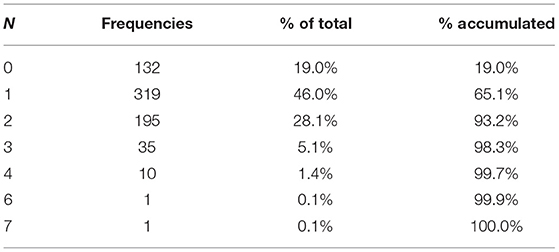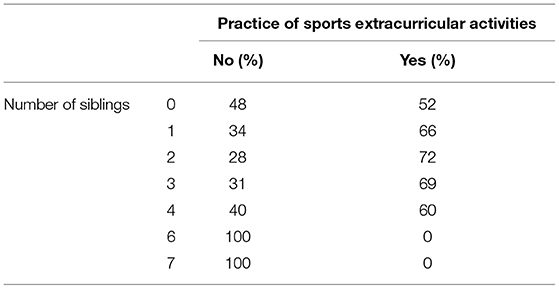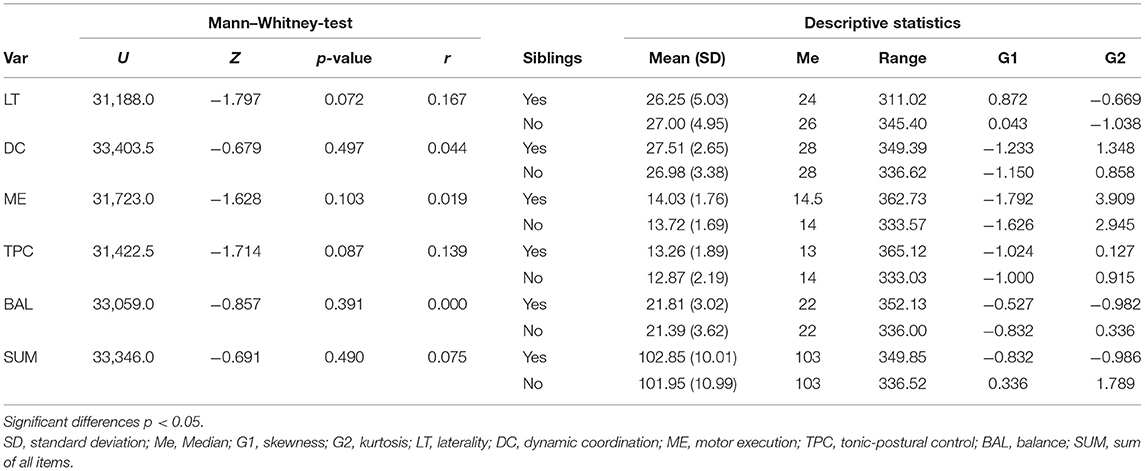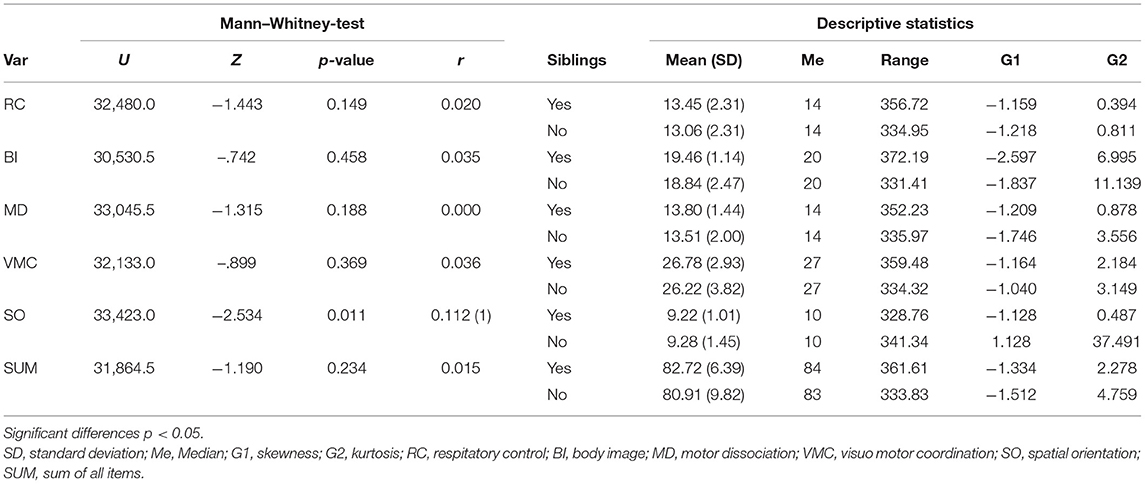- 1Department of Didactics on Physical, Artistic and Music Education, Faculty of Education, Albacete, University of Castilla La Mancha, Ciudad Real, Spain
- 2Department of Methodology of the Behavioral Sciences, Faculty of Psychology, National University of Distance Education (UNED), Madrid, Spain
- 3Degree in Early Childhood Education and Primary Education, Faculty of Education, International University of la Rioja, Madrid, Spain
In early childhood education, there is a great interdependence among motor, affective, and cognitive development. A better understanding of psychomotor development and its variables by pediatricians and those who oversee educational tasks at this stage of development, such as teachers, psychologists, counselors, and parents themselves, can influence the design of educational intervention proposals. To that effect, the present study aims to analyze the influence of some family characteristics such as the condition of being an only child or having siblings and whether the child carries out extracurricular activities linked to physical activities and sports. To achieve this objective, a Checklist of Psychomotor Activities (CPA) assessment instrument was used based on the observation of a sample of 694 children aged 5 years who were enrolled in the second cycle of child education in the province of Albacete. The results show that those children who performed extracurricular activities related to physical activities and sports had a greater development of laterality and postural tonic control than those who did not attend this type of activities. At the same time, differences were found in the affective and relational levels and in the perceptual-motor aspects in favor of children who have siblings compared with children who are only children. There is no other research that addresses both issues in the same study, and this is a strength of the present study.
Introduction
Do the decisions of the parents significantly influence the development of children? This study aims to delve into two aspects that can answer this question, the number of siblings that have the children, and the type of after-school activities the children will do outside the school and how they influence the psychomotor development of 5-year-old children who are in the second cycle of early childhood education of the community of Albacete (Spain).
In the stage of early childhood education, the integral development of students is very important, because it is one of the main objectives of this educational stage. Physical education, motor activity, and psychomotricity are aspects that correlate and directly influence perceptual-motor, physical-motor, cognitive, and effective-relational development (1–4) being an important aspect in childhood inside and outside the school grounds. To know the effects of some variables on this area provides the educators tools for the improvement of psychomotor skills of children in the early stages of primary education.
Motor skills, in its systematic form, physical education, or psychomotricity in early childhood education is one of the subjects or areas that develops these aspects; however, children who carry out extracurricular activities of a sporting nature have an extra motor benefit, of which they only carry out physical activities in schools (5, 6). In turn, it is a decisive component in the parenting style, giving their children participation in extracurricular sports activities (ESAs), (7).
The benefits of ESAs carried out by children at this educational stage have a great impact on the physical, social, emotional, and psychological health of children expressed by various authors (8–10) who similarly believe that extracurricular activities facilitate the development of non-cognitive skills.
Another important variable in this research is the difference in relational psychomotor and affective skills between children who have siblings and those who do not. Authors like Berger and Nuzzo (11) have determined that children who have older siblings achieve motor skills before those older siblings; however, in number, they develop more skills and acquire these faster.
Due to the importance of the mentioned variables, the present research analyses the relevance of ESAs in the development of motor, perceptual, and affective skills and if there are differences in these skills between children who have siblings and those who have not. Next, previous studies on the two variables under study will be presented.
Extracurricular Sports Activities and Their Impact on Motor Development in Children's Education
Motor stimulation not only can benefit the physical development of 5-year-olds but in turn brings positive skills in cognitive and affective factors, since good motor development has a direct impact on perceptual, physical, motor, cognitive, and affective faculties. The work of motor patterns in early childhood is the basis for the realization of basic, as well as specialized tasks that are present in daily activities (12, 13). Motor development is characterized by being a process that is carried out throughout the development of the infant, composed of qualitative and quantitative aspects (7, 14, 15). ESAs bring cognitive benefits that are closely related to psychomotor aspects such as laterality, balance, spatial notion, perception, and postural tonic control. There are several studies that corroborate this relationship, for example.
Rasberry et al. (16) found 251 positive associations in the analysis of 43 previous studies that analyze the benefit of ESAs and its relationship to the cognitive aspects expressed through academic performance, academic behavior, cognitive skills, and student attitudes. Another reference that corroborates the benefit of the ESAs is the study carried out by Temple et al. (17), who corroborated that the most active after-school activities were associated with a higher level of motor skills. And finally, the study developed by Raudsepp and Päll (18) confirmed that performing specific activities significantly improved object control skills.
Relational Affective Factors Implicit in Extracurricular Sports Activities
The factors that influence the socialization process that are implicit in the ESAs (such as the affective factors and relational, motivational, and experiences of pleasure of acting and performing a sports activity that leads to socialization with family, colleagues, sports coaches, and teachers) bring with them not only emotional but psychological benefits as posed in the study of Bailey et al. (19). In turn, participating in an active and consenting way of expressing skills through its execution improves the social integration and brings emotional and psychomotor benefits (20).
According to Sanmartín (21), sports is recognized as an inclusive space, which will provide the individual with benefits in its psychological and social aspects. As we see, there is a conviction that habits established in the early ages will engage them significantly, marking a continuity of this style in adulthood, and also that if active lifestyles accompany healthy lifestyles, we will be able to enhance them through physical activities and sports in the early stages of childhood by encouraging the development of potentially healthy (mentally and physically) individuals.
Differences in Motor Development Between Children Who Have Siblings or Not
The children's brain is constantly learning and is highly perceptive of environmental information through movement and exploration. Related to it, is relevant to ask: is there really a difference in the motor development between children who have siblings or those who do not have siblings?
To answer this question, it is important to take into consideration that the child psychomotricity development is mediated by the environment but also this process is related to its physical constitution, namely, there are basic and egalitarian aspects in each individual; however, the speed of information processing will be different for those children who possess imitative behavior of an equal that stimulates it, not only from the motor, psychomotor, or perceptive point of view but also stimulating the various emotions that can be fostered through peer-to-peer play (22). In the same line, the order of birth in a family is also a factor that can affect the development of motor capacity.
Children with older siblings have better motor performance than only or first-born children (11, 23). It is found that one of the typical sequences is that an older child initially performs a task while the younger siblings watch or spend a lot of time observing the performance of the older sibling and replicating his/her movements (24). Older siblings provide more advanced development models for younger siblings and help to create an enriched and stimulating environment that seems to improve the development of younger siblings (22, 25). More recently, Giagazoglou et al. (26) analyzed motor development in light of the order of birth occupied by the child and concluded that this order did not have an influence on motor development.
Relational Affective Factors in Children Who Have Siblings or Not
From a psychomotor and affective-relational point of view, most studies establish that there is a significant difference between children who have older siblings and those who are an only child; from a playful point of view in motor activities, the older sibling impersonates a figure of secondary attachment, in the presence of which the younger sibling can explore the context more safely since he/she feels being accompanied and safe with him/her, or the older siblings diminish the fear of strangers, becoming a significant fraternal interaction (27). However, other studies, such as Poston and Falbo (28), mentioned that affective-relational differences are in balance between children with or without siblings of Chinese origin and in some case in some variables slightly higher in children who have siblings.
Method
Participants
Information has been obtained from 694 5-year-olds schooled in the third cycle of early childhood education. Information has been collected and provided by teachers from 32 child education groups, from the towns of Almansa, La Roda, Albacete, Chinchilla, Aguas Nuevas, Alcázar de San Juan, Villarobledo, Casas Ibáñez, Riópar, Munera, and Quintanar del Rey. The sample has been non-probabilistic in nature; the sampling technique has been used on purpose, as voluntary collaboration has been requested in all schools in Albacete province, and we have finally worked with the schools that agreed to participate.
The sample consists of 46.7% girls and 53.3% boys. Most participants belong to public schools 69.5 vs. 30.5% who are students of concerted schools. It should be noted that 65% of children practice some extracurricular activities of a sporting type and 81.4% have siblings.
Instruments
The Checklist of Psychomotor Activities (CPA) was used to measure children's psychomotor development. The CPA test consists of three scales:
- Scale of Psycho-Motor Aspects (SPMA), composed of five factors or dimensions: Laterality (LAT; seven items), Dynamic Coordination (DC; six items), Tonic-Postural Control (CTP; three items), Motor Execution (ME; three items), and Balance (BAL; five items).
- Perceptual Aspects Scale (PAS), composed of five factors or dimensions: Respiratory Control (RC; three items), Body Image (BI; four items), Motor Dissociation (MD; three items), Visuo-Motor Coordination (VMC; six items), and Spatial Orientation (SO; two items).
- Scale of Socio-Emotional Aspects (SSEA), composed of two factors or dimensions: Emotional Control (EC; six items) and Social Relations (SR; five items).
Participants were evaluated by their teachers using a 5-point Likert scale from 1 (never) to 5 (always), depending on their ability to perform the proposed task on each item. The CPA has been shown to have adequate psychometric properties with good reliability (Cronbach's alpha) ranging from 0.572 (laterality) to 0.872 (balance) on the SPMA scale, between 0.514 (spatial orientation) and 0.825 (respiratory control) on the PAS scale, and between 0.572 (emotional control) and 0.800 (social relations) on the SSEA scale. Reliability considering the entire scale is remarkably high: 0.935. The authors also present evidence of factorial, content, and discriminatory validity.
Procedure
First, different schools in the province of Albacete, Spain, were contacted. An explanatory document with the objectives of the research was presented to the school's directors, and their voluntary participation was requested. Second, informed consent was requested from parents in schools that eventually agreed to participate; parents also answered a questionnaire asking about the other study variables: whether they have siblings and whether they do ESAs. Third, physical education teachers were training to use the CPA instrument. Fourth, the teachers in each course did the evaluation of the children with the help of a member of the research team, during an hour of physical education class. Finally, CPA evaluation data and parent questionnaires were combined into a database that was used for analysis.
Data Design and Analysis
A quantitative, non-experimental, descriptive, and explanatory cross-cutting study was carried out. It is also known as simple prospective ex post facto design.
Variables
The variables that have been considered to establish the comparison are family members (if you are an only child or otherwise have siblings) and education (if you do ESAs) of the participating children.
Data analyses include two parts: the first part contains the description of the variables according to their frequency and percentage distribution; the second part contains the analysis of the differences between groups that has been carried out through the non-parametric U tests of Mann–Whitney and Kruskal–Wallis.
Results
Description of the Variables Analyzed
Tables 1–3 present the distribution of the variables studied. Table 1 shows that 65% of the sample have at least one sibling, while only 19% do not have siblings. On the other hand, in Table 2, it can also be observed that most children (again 65%) practice sports school activities. For its part, in Table 3, it is appreciated that as the number of siblings increases, the foray of students in ESAs, being only children with 52%, the least favored in this range of 0–4 siblings, however, it can be seen that 52% in front of the students have siblings or do not benefit from the relational affective stimulation that the extracurricular activities gives.
Differences Depending on the Practice of Extracurricular Sports Activities
The Mann–Whitney U-test results according to the practice of after-school sports activities in the physical-motor aspects are presented in Table 4. It is observed that there are significant differences in laterality and postural tonic control, with better performance (higher average ranges) in children who practice some extracurricular activities of sports type.
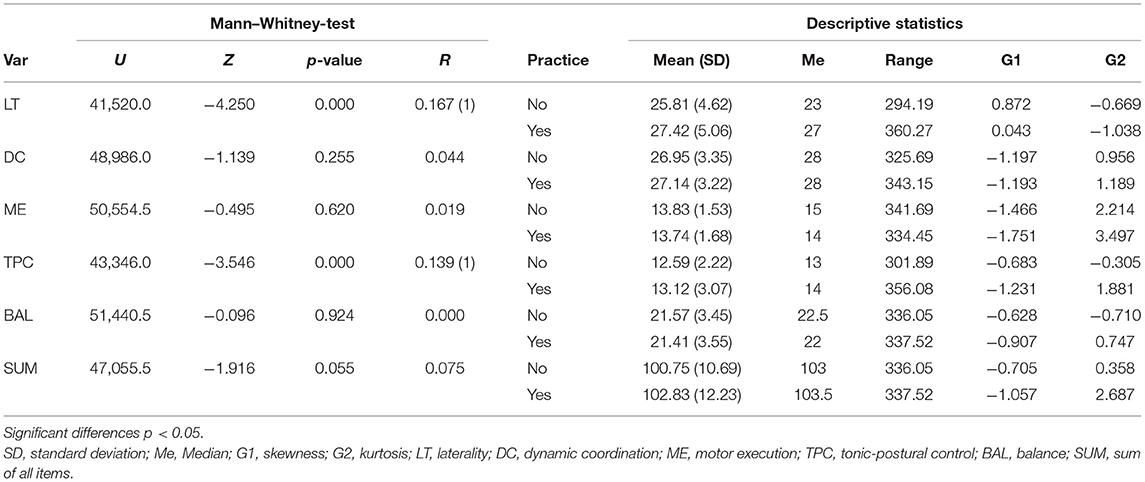
Table 4. Mann–Whitney-test and descriptive statistics according to the practice of sports activities on the physical-motor aspects.
Table 5 presents the results of the Mann–Whitney-test and descriptive statistics on the perceptual-motor aspects according to the practice of extracurricular activities of sports type. In the table, it can be observed that there are only significant differences in spatial orientation, these being favorable to the group that practices extracurricular activities of sports type. In other perceptual-motor areas, there are no significant differences.
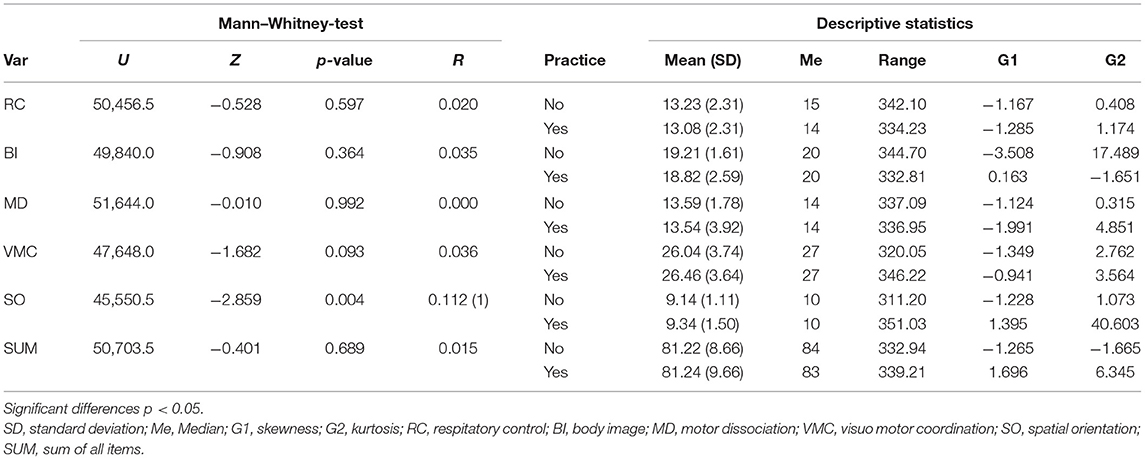
Table 5. Mann–Whitney-test and descriptive statistics according to the practice of sports activities on the perceptual-motor aspects.
Table 6 presents the results in the affective-relational aspects. As can be seen in the table, there are no significant differences in these aspects.

Table 6. Mann–Whitney-test and descriptive statistics according to the practice of sports activities on the affective-relational aspects.
Differences in Children With and Without Siblings
Table 7 presents the differences according to the presence of siblings in the family for physical-motor variables, showing that there are no significant differences between children who have siblings and those who do not have them in any physical-motor variable.
Table 8 shows the results of the Mann–Whitney-test to make differences between children who have siblings and those who do not have them in the perceptual-motor aspects. There are significant differences in spatial orientation, being favorable to the group that has no siblings. In other perceptual-motor areas, there are no significant differences. Finally, Table 9 presents the results in the affective-relational aspects. There are significant differences in social relationships (higher score ranges for children who have siblings).
Discussion
Many authors have investigated on ESAs, for example, Calero et al. (29), Delgado-Lobete and Montes-Montes (30), Pérez and Geidel (31), and Park et al. (32). In addition to those studies, this research proposes a global information based on the psychomotor development and the affective relational implications on this type of activities on students who have or do not have siblings. At the motor level, specifically, children have differences in laterality and postural tonic control, with better average children practicing ESAs; spatial orientation is another aspect significantly developed in children who participate in ESAs and do not have siblings. Regarding relational affective skills, this area is much nurtured by the ESAs and by the children who have siblings.
There is a belief that children who have siblings are more developed at the motor level than those who do not have siblings; however, this research determines that there are no significant differences in most of the motor physical and perceptive variables. Regarding spatial orientation, children who do not have siblings have greater stimulation in this area, since from an early age they are forced to independently explore the environment in which they are located in, which leads to greater motor development skills, unlike children who have siblings, who can learn by imitation, but will not necessarily have greater motor skills. Space orientation brings great cognitive benefits, as it is the basis for the acquisition of reading, writing, and calculation as corroborated by studies (11, 23, 24, 26), with children without siblings being more benefited academically than those with siblings. Downey (33) highlighted in his research that cognitive stimulation is lower for children who have siblings, as the resources of the parents are diluted as the family grows.
In this research, it is recognized that ESAs provide a great benefit in children who have siblings or not, being doubly benefited at the relational affective level those who have siblings, and this result coincides with those found by authors such as Vera (34) or Villalobos and Mondragón (35). The last authors conducted a comparative study of the social skills of only children and other children. They found a lower self-concept in only children. In turn, Kitzmann et al. (36) highlighted as a result that only children are less accepted by their class group, being victimized and bullied by groups of classmates, suggesting that those with siblings better manage the conflict. Considering that these characteristics are closely related to social skills, it is affirmed that the ESAs are beneficial for only children, taking into account the outcome of this study and the other research mentioned above, since coexistence, sharing, follow-up of instructions, and collaborative learning that occurs in sports permit the children to improve their emotional development. On the other hand, possessing a habit and a recreational physical intention in which the children can use their physical skills may also strengthen their emotional development.
These results confirm, as do the research of Eime et al. (37), Fredricks and Eccles (38), Dimech and Seiler (39), or Vella et al. (40), that sports activities are beneficial to children during their development.
Conclusions, Limitations, and Future Studies
At the motor level, it is once again demonstrated that ESAs are beneficial for the child population. In addition, spatial orientation is an area that brings benefits that are related to cognitive development especially at those early ages in the acquisition of basic instrumental reading subjects, writing, and calculation. It is also appreciated that there are no differences between children who have siblings and those who do not at the level of laterality, postural tonic, and perceptual aspects—motor.
At the affective-relational level, it is of great benefit to all children the ESAs but more for those who do not have siblings, since it provides them with a space in which they can establish social relationships, which can sometimes deteriorate within the school, giving it a second opportunity to develop in the affective development and in the establishment of social relationships, improving their community skills, reducing anxiety and psychological difficulties, and acquiring skills for better conflict management, among others.
At the level of educational and community policies, it is necessary for communities to facilitate and promote within educational institutions, or sports institutions, access to ESAs and in this way promote a better society, stimulating the parents of only children to get into these activities, exposing the benefits to them, and providing aid plans and transfer, among others, to parents of large families who, seeing their abilities diminished, deprive children of the participation in ESAs.
Some of the limitations found in this research are that the sample is not probabilistic and not generalizable to the Spanish population; however, Castilla la Mancha region is in central Spain and can be a good reflection of the country's behavior. For future studies, it should be interesting to analyze in-depth the effects of an interventional program to see the extent to which space orientation affects the psychomotor development in both children who are only children and those with siblings. Since space orientation plays an important role in acquiring knowledge of other instrumental materials, as well as improving the affective and relational dominance of children, the intervention program may be directed to improve the spatial orientation skills in both groups.
Data Availability Statement
The original contributions presented in the study are included in the article/supplementary material, further inquiries can be directed to the corresponding authors.
Ethics Statement
The studies involving human participants were reviewed and approved by School Ethics and Conviction Committee CRA CALAR DEL MUNDO, Albacete, Spain. Written informed consent to participate in this study was provided by the participants' legal guardian/next of kin.
Author Contributions
PG-M: research design, information gathering, and report preparation. SR-M: data analysis and report preparation. CR-F: review of the bibliography and preparation of the report. All authors contributed to the article and approved the submitted version.
Conflict of Interest
The authors declare that the research was conducted in the absence of any commercial or financial relationships that could be construed as a potential conflict of interest.
References
1. Camargos E, Maciel R. The importance of psychomotricity in children education. Multidiscip Core Sci J Knowl. (2016) 1:254–75. Retrieved from: https://www.nucleodoconhecimento.com.br/education/psychomotor-ineducation-and-child
2. Cañizares JM, Carbonero C. Temario de oposiciones de educación física para Primaria. Legislación L.O.E. Wanceulen (2009).
3. Del Águila K, Reyes D. Neuroeducation: importance of perceptual motor skills for learning the pyramid of human development. Educació. (2017) 23:107–24.
4. Rigal R. Motor Education and Psychomotor Education in Preschool and Elementary School. Barcelona: Inde (2006).
5. Simoncini K, Caltabiono N. Young school-aged children's behavior and their participation in extracurricular activities. Aust J Early Child Med. (2012) 37:35–4. doi: 10.1177/183693911203700306
6. Simpkins S, Vest A, Becnel J. Participating in sport and music activities in adolescence: the role of activity participation and motivational beliefs during elementary school. J Youth Adolesc Med. (2010) 39:1368–86. doi: 10.1007/s10964-009-9448-2
8. Bailey R. Physical education and sport in schools: a review of benefits and outcomes. J Sch Health. (2006) 76:397–401. doi: 10.1111/j.1746-1561.2006.00132.x
9. Pastor - Vicedo JC, Gil-Madrona P, Tortosa- Martínez M, Martínez- Martínez J. Effects of an extracurricular physical activity program on overweight and obese ESO first-cycle children. J Sports Psychol. (2012) 21:379–85. Retrieved from: https://archives.rpd-online.com/article/download/1133/1133-3522-1-PB.pdf
10. Sollerhed A, Ejlertsson G. Physical benefits of expanded physical education in primary school: findings from a 3-year intervention study in Sweden. Scand J Med Sci Sports Med. (2008) 18:102–7. doi: 10.1111/j.1600-0838.2007.00636.x
11. Berger SE, Nuzzo K. Older siblings influence younger siblings' motor development. infant and child development. Int J Res Pract. (2008) 17:607–15. doi: 10.1002/icd.571
12. Gallahue D. Concepts to maximize the development of specialized motion skill. Magazine da Educação Física/UEM. (2008) 16:197–202.
13. Feder K, Majnemer A, Bourbonnais D, Platt R, Blayney M, Synnes A. Handwriting performance in preterm children compared with term peers at age 6 to 7 years. Dev Med Child Neurol. (2005) 47:163–70. doi: 10.1017/S0012162205000307
14. Baena A, Granero A, Ruiz PJ. Procedures and instruments for the measurement and evaluation of motor development in the education system. Assoc Editors. (2010) 2:63–76.
15. Goodway J, Ozmun J, Gallahue L. Understanding Motor Development: Infants, Children, Adolescents, Adults. Burlington, MA: Jones & Bartlett Learning (2019).
16. Rasberry C, Lee S, Robin L, Laris B, Russell L, Coyle K, et al. The association between school-based physical activity, including physical education, and academic performance: a systematic review of the literature. Prev Med. (2011) 52:10–20. doi: 10.1016/j.ypmed.2011.01.027
17. Temple V, Crane J, Brown A, Williams B, Bell R. Recreational activities and motor skills of children in kindergarten. Phys Educ Sport Pedagogy Med. (2016) 21:268–80. doi: 10.1080/17408989.2014.924494
18. Raudsepp L, Päll P. The relationship between fundamental motor skills and outside-school physical activity of elementary school children. Pediatr Exerc Sci Med. (2011) 18:426–35. doi: 10.1123/pes.18.4.426
19. Bailey R, Armour K, Kirk D, Jess M, Pickup I, Sandford R, et al. The educational benefits claimed for physical education and school sport: an academic review. Res Papers Educ. (2009) 24:1–27. doi: 10.1080/02671520701809817
20. Pomohaci M, Sopa I. Extracurricular sport activities and their importance in children socialization and integration process. Sci Bull. (2017) 22:46–59. doi: 10.1515/bsaft-2017-0007
21. Sanmartín M. The value of sport in the integral education of the human being. J Educ Med. (2004) 335:105–26. Retrieved from: https://www.educacionyfp.gob.es/dam/jcr:1ea03671-4ead-42b8-8731-50d39893a0ef/re33510-pdf.pdf
22. Barr R, Hayne H. It's not what you know, it's who you know: older siblings facilitate imitation during infancy. Int J Early Years Educ. (2003) 11:7–21. doi: 10.1080/09669760304714
23. Krombholz H. Physical performance in relation to age, sex, birth order, social class, and sports activities of preschool children. Percept Motor Skills. (2006) 102:477–84. doi: 10.2466/pms.102.2.477-484
24. Erbaugh S, Clifton M. Sibling relationships of preschool-aged children in gross motor environments. Res Q Exerc Sport. (1984) 55:323–31. doi: 10.1080/02701367.1984.10608410
25. Reid V, Stahl D, Striano T. The presence or absence of older siblings and variation in infant goal-directed motor development. Int J Behav Dev Med. (2010) 34:325–9. doi: 10.1177/0165025409337570
26. Giagazoglou P, Kabitsis N, Kokaridas D, Zaragas C, Katartzi E, Kabitsis C. The movement assessment battery in Greek preschoolers: the impact of age, gender, birth order, and physical activity on motor outcome. Res Dev Disabil. (2011) 32:2577–82. doi: 10.1016/j.ridd.2011.06.020
27. Arranz E, Yenes F, Olabarrieta F, Martín JL. Sibling relations and psychological development in schoolchildren. Child Learn. (2001) 24:361–77. doi: 10.1174/021037001316949275
28. Poston D, Falbo T. Scholastic and personality characteristics of only children and children with siblings in China. Int Fam Plan Persp. (1990) 16:45–54. doi: 10.2307/2133467
29. Calero I, Sánchez A, Núñez J. Analysis of extracurricular activities based on gender variable in primary school students in the province of Granada. Eur Sci J. (2015) 11:480–98.
30. Delgado-Lobete L, Montes-Montes R. Practice of after-school physical activity and sports preferences in Spanish preschoolers and immigrants: a pilot study. Electr J Occup Ther. (2015) 22:1–12.
31. Sevilla-Pérez MD, Runte-Geidel A. The use of after-school activities in early childhood education, inequalities and educational policies. Int J Support Inclusion Speech Ther Soc Multicult. (2016) 2:201–17. Retrieved from: https://revistaselectronicas.ujaen.es/index.php/riai/article/view/4245/3470
32. Park S, Chiu W, Won D. Effects of physical education, extracurricular sports activities, and leisure satisfaction on adolescent aggressive behavior: a latent growth modeling approach. PLoS ONE. (2017) 12:0174674. doi: 10.1371/journal.pone.0174674
33. Downey D. Number of siblings and intellectual development: the resource dilution explanation. Am Psychol. (2001) 56:497–504. doi: 10.1037/0003-066X.56.6-7.497
34. Vera A. Social Skills and Self-concept in Unique Children and with Siblings, from Schools in Lima Metropolitana. Peruvian University of Applied Sciences. Available online at: http://hdl.handle.net/10757/619096 (accessed February 12, 2021).
35. Aranda C, Chaves L. Self-concept and social skills in children as unique children and children with siblings. Psycho Educ Refl Prop. (2017) 3:38–44. Retrieved from: https://psicoeducativa.iztacala.unam.mx/revista/index.php/rpsicoedu/article/view/64/195
36. Kitzmann K, Cohen R, Lockwood R. Are only children missing out? Comparison of the peer-related social competence of only children and siblings. J Soc Pers Relat. (2020) 19:299–316. doi: 10.1177/0265407502193001
37. Eime R, Young JA, Harvey J, Charity Payne W. A systematic review of the psychological and social benefits of participation in sport for children and adolescents: informing development of a conceptual model of health through sport. Int J Behav Nutr Phys Activity. (2011) 10:98–119. doi: 10.1186/1479-5868-10-98
38. Fredricks J, Eccles J. Is extracurricular participation associated with beneficial outcomes? Concurrent and longitudinal relations. Dev Psychol. (2006) 42:698–713. doi: 10.1037/0012-1649.42.4.698
39. Dimech A, Seiler R. Extra-curricular sport participation: a potential buffer against social anxiety symptoms in primary school children. Psychol Sport Exerc. (2011) 12:347–54. doi: 10.1016/j.psychsport.2011.03.007
Keywords: psychomotor development, infant education, physical education, extracurricular activities, only children
Citation: Gil-Madrona P, Romero-Martínez SJ and Roz-Faraco CC (2021) Extracurricular Physical Activities and the Condition of Being an Only Child as a Conditioning Factor in the Psychomotor Development of 5-Year-Old Children. Front. Pediatr. 9:684418. doi: 10.3389/fped.2021.684418
Received: 23 March 2021; Accepted: 01 June 2021;
Published: 05 July 2021.
Edited by:
Nancy Getchell, University of Delaware, United StatesReviewed by:
Arturo Diaz Suarez, Universidad de Murcia, SpainMaría Luisa Zagalaz-Sánchez, University of Jaén, Spain
Copyright © 2021 Gil-Madrona, Romero-Martínez and Roz-Faraco. This is an open-access article distributed under the terms of the Creative Commons Attribution License (CC BY). The use, distribution or reproduction in other forums is permitted, provided the original author(s) and the copyright owner(s) are credited and that the original publication in this journal is cited, in accordance with accepted academic practice. No use, distribution or reproduction is permitted which does not comply with these terms.
*Correspondence: Pedro Gil-Madrona, cGVkcm8uZ2lsQHVjbG0uZXM=; Sonia J. Romero-Martínez, c2pyb21lcm9AcHNpLnVuZWQuZXM=; Carmen C. Roz-Faraco, Y2FybWVuLnJvekB1bmlyLmVz
 Pedro Gil-Madrona
Pedro Gil-Madrona Sonia J. Romero-Martínez2*
Sonia J. Romero-Martínez2*